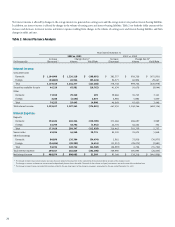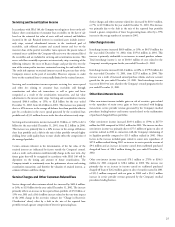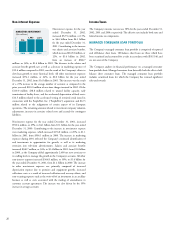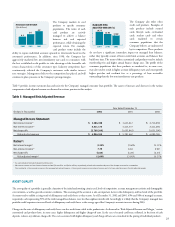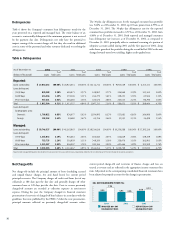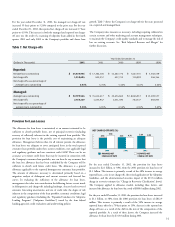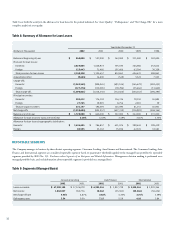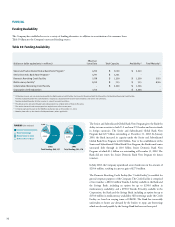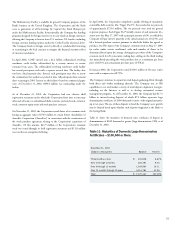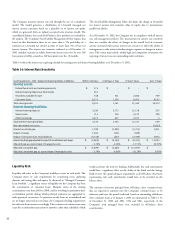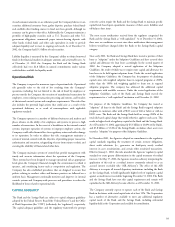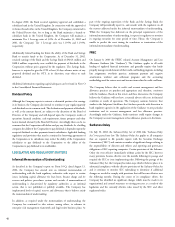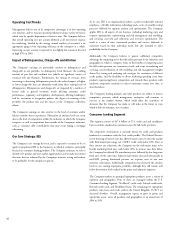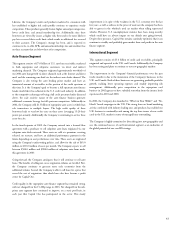Capital One 2002 Annual Report Download - page 35
Download and view the complete annual report
Please find page 35 of the 2002 Capital One annual report below. You can navigate through the pages in the report by either clicking on the pages listed below, or by using the keyword search tool below to find specific information within the annual report.
33
Consumer Lending Segment
The Consumer Lending segment consists primarily of domestic credit card
and installment lending activities. Total Consumer Lending segment loans
increased 27% to $47.3 billion at December 31, 2002, compared to $37.3
billion at December 31, 2001. The achieved loan growth in this segment
reflects the Company’s substantial opportunity to grow loans using IBS.
Net charge-offs of Consumer Lending segment loans increased $875.8
million, or 60%, while average Consumer Lending segment loans for the
year ended December 31, 2002 grew 41% compared to the same period in
the prior year. For the year ended December 31, 2002, the Consumer
Lending segment’s net charge-offs as a percentage of average Consumer
Lending segment loans outstanding were 5.54%, compared to 4.87% for the
prior year. This increase was consistent with management’s expectations and
was driven by the seasoning of loans in the portfolio and the relatively lower
loan growth experienced in the second half of 2002.
The 30-plus day delinquency rate for the Consumer Lending segment was
5.54% as of December 31, 2002, up 54 basis points from 5.00% as of
December 31, 2001. The increase in delinquencies is due to the seasoning of
the portfolio in addition to the recent downturn in the U.S. economy and
increased unemployment rates.
During the third quarter of 2002, the Company expensed $38.8 million
related to the early termination of leases, unused facility capacity, and
accelerated depreciation of related fixed assets. The Company allocated $35.5
million of these expenses to the Consumer Lending segment.
Auto Finance Segment
The Auto Finance segment consists of automobile lending activities. Total
Auto Finance segment loans outstanding increased 77% to $7.0 billion at
December 31, 2002, compared to $4.0 billion at December 31, 2001. The
increase in auto loans outstanding was the result of expanded organizational
capabilities and increased reliance on proven IBS concepts, which attracted
new dealer-sourced and direct loan volume.
Net charge-offs of Auto Finance segment loans increased $132.9 million, or
154%, while average Auto Finance loans for the year ended December 31,
2002 grew 183%, compared to the same period in the prior year. For the
year ended December 31, 2002, the Auto Finance segment’s net charge-offs
as a percentage of average Auto Finance segment loans outstanding were
3.82% compared to 4.25% for the prior year. The decrease is primarily the
result of improved credit quality on the Company’s average loan portfolio for
2003. The decrease occurred despite deterioration in used car values, which
caused higher loss severity.
The 30-plus day delinquency rate for the Auto Finance segment was 7.15% as
of December 31, 2002, up 156 basis points from 5.59% as of December 31,
2001. The increase in delinquencies was primarily the result of an increase in
higher yielding, lower credit quality loans and higher unemployment.
During the year, the Company sold $1.5 billion of auto loans to multiple
buyers. These transactions resulted in gains of $28.2 million for the Auto
Finance segment. These gains were offset in part by compensation expense of
$14.5 million ($9.0 million after taxes) that was recognized and allocated to
the Auto Finance segment for the accelerated vesting provisions of certain
restricted stock issued in connection with the acquisition of PeopleFirst.
International Segment
The International segment consists of all non-domestic consumer lending
activities. Total International segment loans outstanding increased 34% to
$5.3 billion at December 31, 2002, compared to $4.0 billion at December
31, 2001. The increase in total outstandings was principally the result of the
successful application of its IBS to originate loans in the United Kingdom
and Canada.
Net charge-offs of International segment loans increased $61.3 million, or
53% while average International segment loans for the year ended December
31, 2002 grew 46%, compared to the same period in the prior year. For the
year ended December 31, 2002, the International segment’s net charge-offs
as a percentage of average International segment loans outstanding were
3.76% compared to 3.59% for the prior year. The increase was driven
primarily by greater charge-offs compared to loan growth for the Canadian
market.
The 30-plus day delinquency rate for the International segment was 4.18%
as of December 31, 2002, up 34 basis points from 3.84% as of December
31, 2001. International delinquencies increased primarily as a result of the
seasoning of the Canadian credit portfolio and slower Canadian loan growth.
During 2002, the Company realigned certain aspects of its European
operations. Charges related to the realignment of $12.5 million were
recognized and allocated to the International segment.



